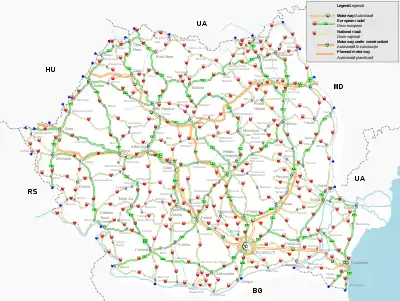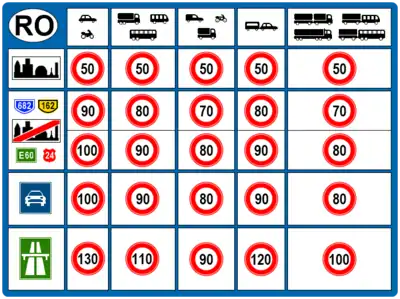| Transport in Romania |
|---|
| Companies |
| History |
|---|
| Companies |
| Industry |
|
| Rankings |
|
| Related topics |
Transportation infrastructure in Romania is the property of the state, and is administered by the Ministry of Transport and Infrastructure, Constructions and Tourism, except when operated as a concession, in which case the concessions are made by the Ministry of Administration and Interior.[1]
The country's most important waterway is the river Danube. The largest port is that of Constanța, which is the second largest port at the Black Sea.
With over 13 million passengers Bucharest Airport is a major international airport and European transportation hub. Air travel is used for greater distances within Romania but faces competition from the state-owned CFR's rail network. Public transport is available in most areas.
History
Romania has a system of large, navigable rivers, such as the Danube, Olt and Mureș that cross the country.
The first important human improvements were the Roman roads linking major settlements and providing quick passage for marching armies.
Railway transport

A fast-growing number of Romania's major cities have modern tram or light rail networks, including Bucharest, Timișoara, Cluj-Napoca and Oradea. Recently the tram has seen a very big revival with many experiments such as ground level power supply in Oradea.
Roads and automotive transport


According to the CIA Factbook, in 2012 Romania had a total road network of 84,185 km, out of which 49,873 km were paved and 34,312 km unpaved.[2] Romania's National Institute of Statistics (INS) 2019 transport report stated that total road network is 86,391 km: 38,166 km (44.2%) modernized roads (92.8% with asphalt pavements of heavy/medium type and 7.8% with concrete), 21,365 km (24.7%) with light asphalt road clothing, 17,831 km (20.6%) cobblestone roads and 9,021 km (10.5%) dirt roads.[3]
Motorways
Motorways are identified by A followed by a number. As of December 2022, Romania has 995 km of highway completed with more under planning or construction. In recent years, a master plan for the national motorway network has been developed and approved by the European Commission in July 2015.
Currently the A1 motorway, part of the northern branch of the Pan European IV Corridor, is open on 456 km. Under construction are the segments Curtea de Argeș—Pitești (30 km). Margina—Holdea (13 km) and Boița—Curtea de Argeș (73 km) have yet to start construction. It has a total length of 576 km.
The A2 motorway was the first motorway in Romania opened on all its segments, with a length of 205 km. It links Bucharest to Constanța (junction with A4)
The A3 motorway, which is the largest motorway project in Eastern Europe with a length of 588 km from Bucharest to Oradea (near the Hungarian border), is open on 173 km. The segment Chețani—Câmpia Turzii (15.7 km) is under construction. All segments between Nădășelu and Oradea have been tendered by the end of 2020. The remaining sections are still in the planned phase.
The A4 motorway is operational on 22 km, from Ovidiu to Agigea (also known as the Constanța bypass). Another 45 km are planned, from Agigea to Vama Veche (at the border with Bulgaria).
The A6 motorway is also part of the Pan European IV Corridor, but near Lugoj it starts as the southern branch, that connects the cities of Sofia, Istanbul and Athens. It has a length of 270 km, of which 11.4 km between A1 and Lugoj bypass are open.
The A7 motorway starts from the A3 (near Ploiești), linking it to the region of Moldavia and further to the Ukrainian border. From its planned 450 km, 16 km are open near Bacău, which serve as the bypass for that city.
The A10 motorway is the first motorway which links two motorways in Romania: A1 (near Sebeș) and A3 (near Turda). It has 70 km, and since 2021, it has been operational on its entire length.
The A11 motorway is a 135 km motorway, the second to connect A1 with A3 this time between Arad and Oradea, of which a 2.4 km stretch near Arad called the Arad bypass is open.
Statistics
According to the Romanian "Direcţia Regim Permise de Conducere şi Înmatriculare a Vehiculelor", in 2017 there were 7,635,000 vehicles (of which 1,320,230 in Bucharest),[4] and 8,900,000 in 2019.[5] It is estimated that by 2021 there will be more than 10 million registered cars in Romania.[5]
In 2016 62% of road fatalities occurred in urban area,[6] Romania has 1189 fatalities in urban area, that is 60 killed in urban area per million inhabitants, or 3.2 times more than EU average of 19. This makes Romania the EU member state with the most fatalities per million population, 42.9% more fatalities than the second country, Hungary.[6]
Metro
Bucharest is the only city in Romania which has an underground railway system, comprising both the Bucharest Metro and the light rail system of the Regia Autonomă de Transport București. Although construction was planned to begin in 1941, decades of delays meant the Bucharest Metro was only opened in 1979. It now forms the backbone of Bucharest public transport network with an average of 800,000 passengers during the workweek.[7] In total, the network is 71 km long and has 53 stations.
Proposals to build metros have been put forward for Cluj-Napoca[8] and Timișoara.
Air transport
The air traffic in Romania reached 20.28 million passengers in 2017[9] and 21 million passengers in 2022.[10]
The national carrier of Romania is TAROM, the largest Romanian airline is Blue Air while Wizz Air has the largest share of Romania's air transport market.[11]
Airports
There are 20 airports in Romania (estimated as of 2006).
Water transport
Romanian companies operate over 700 ships of which 400 are registered in Romania. Romania's 110 shipping firms employ 12,500 personnel at sea and 15,500 on shore. Each year, 105 million tonnes of goods and 1 million passengers are transported by sea. Marine transport is responsible for 52% of Romania's imports and exports.
Ports
- With terminals:
- Port of Constanța (the largest port and shipyard in the Black Sea and one of the busiest ports in Europe)
- Port of Galați (on the Danube)
- Brăila (on the Danube)
- Tulcea (on the Danube)
- Other Black Sea ports:
- Other ports on the Danube:
- Ports on the Danube-Black Sea Canal:
- Cernavodă
- Poarta Albă
- Constanța Sud
- Agigea
Waterways
As of 2006, there are 1,731 km of navigable waterways of which:
- 1,075 km on Danube River
- 524 km on secondary branches
- 132 km on canals
In 2004, according to europaworld.com, 19 million passenger-km and 4 billion ton-km were carried through these waterways.
Merchant fleet
The merchant marine has seen a dramatic drop in capacity during the first decade of the 21st century:
- from 142 ships (1,000 gross tonnage (GT) or over) totaling 1,154,127 GT/1,612,314 tonnes deadweight (DWT) 1999
- to 19 ships (1,000 GT or over) 146,307 GT/165,548 DWT in 2007.
These include: 13 cargo ships, 1 passenger ship, 2 passenger/cargo ships, 2 petroleum tankers, 1 roll-on/roll-off.
50 other ships are registered in other countries: Cambodia 1, Georgia 15, North Korea 6, Malta 10, Marshall Islands 1, Panama 8, Sierra Leone 2, Saint Kitts and Nevis 1, Saint Vincent and the Grenadines 1, Syria 4, Tuvalu 1, unknown 4.
International sea-borne freight traffic
- Goods loaded: 18.2 million tons
- Goods unloaded: 22.3 million tons (2004)
Pipelines
- Oil: 2,427 km
- Natural gas: 3,508 km (2006)
See also
References
- ↑ "Romania". The World Bank. Archived from the original on 14 June 2008. Retrieved 23 November 2009.
- ↑ "Romania". The World Factbook. Central Intelligence Agency. Retrieved 20 October 2022.
- ↑ Institutul Național de Statistică (April 2020). Lungimea căilor de transport, la sfârşitul anului 2019 (PDF) (in Romanian).
- ↑ "DRPCIV: Parcul auto naţional a crescut cu aproape 9% în 2017 şi a depăşit 7,63 de milioane de autovehicule". Agerpres (in Romanian). 4 February 2018. Archived from the original on 31 July 2018. Retrieved 31 July 2018.
- 1 2 Gubandru, Cristian (12 January 2020). "Parcul auto din Romania va depasi 9 milioane de masini anul acesta". Wall-Street (in Romanian). Archived from the original on 28 January 2021. Retrieved 9 September 2020.
- 1 2 European Commission, Traffic Safety Basic Facts on Urban Areas, European Commission, Directorate General for Transport, June 2018
- ↑ "Bucharest Metrorex, Romania". Railway-Technology.com. Archived from the original on 24 March 2010. Retrieved 8 March 2010.
- ↑ "Metrou pe sub Cluj si troleibuz pana la Gilau". infrastructura.info (in Romanian). 3 March 2008. Archived from the original on 21 July 2011. Retrieved 4 July 2009.
- ↑ Ghira, Andrada (3 February 2018). "Record pentru aeroporturile din România în 2017: peste 20 de milioane de pasageri transportaţi". Economica.net (in Romanian). Archived from the original on 5 August 2018. Retrieved 5 August 2018.
- ↑ "Romania: Airlines by number of passengers 2022". Statista. Retrieved 27 November 2023.
- ↑ Casey, David (16 June 2020). "Wizz Air to Open Seventh Romanian Base". Routes Online. Archived from the original on 28 September 2020. Retrieved 9 September 2020.